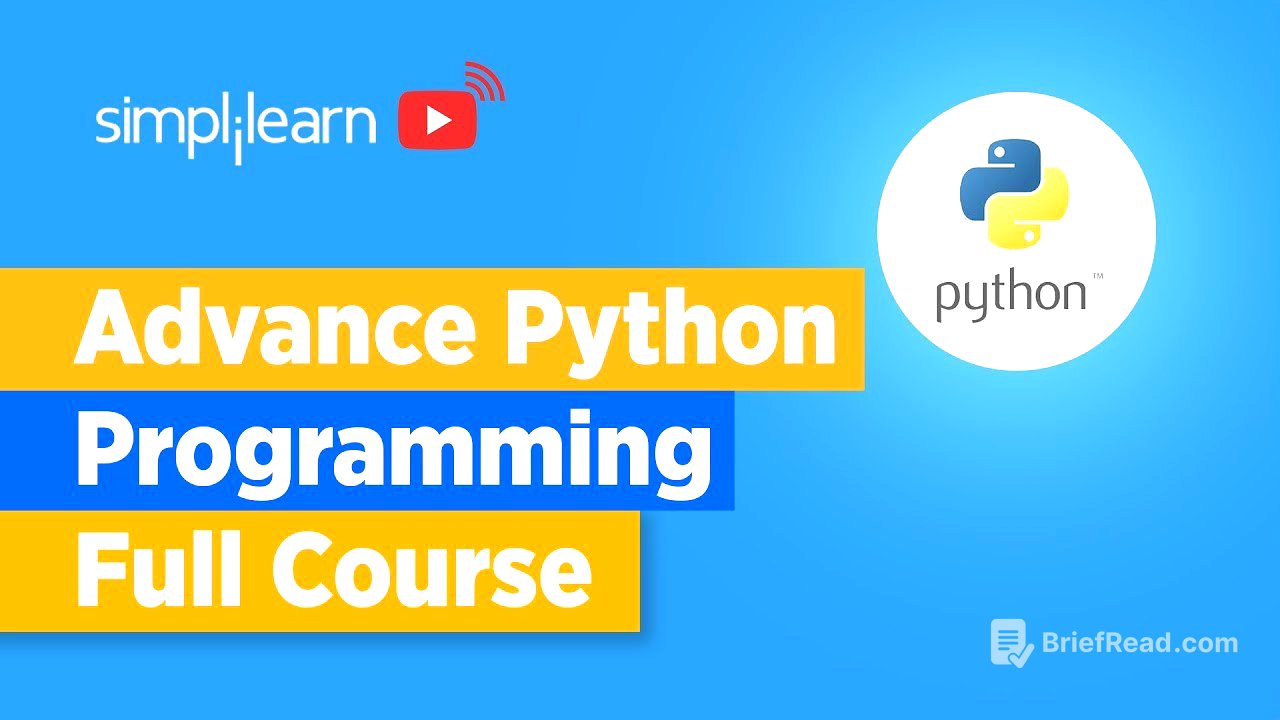TLDR;
Alright, so this advanced Python course by Simplilearn covers a bunch of important concepts for developers. We're talking iterators, packages, generators, list comprehensions, regular expressions, serialization, partial functions, closures, and decorators. Plus, there's a project at the end to put all this learning to good use.
- Iterators and Generators
- Modules and Packages
- List Comprehension and Regular Expressions
- Advanced Functions: Serialization, Partial, Closures, Decorators
Iterators - python advanced programming [0:00]
An iterator is an object that can be iterated upon, meaning you can traverse through its values and perform operations. Technically, it implements the iterator protocol with iter and next methods. For example, you can iterate through a list, string, or dictionary using a for loop. The iter function creates an iterator from an iterable, and the next function moves to the next object. When all objects have been traversed, a StopIteration exception is raised. For loops use this same protocol internally. Generators use functions with the yield keyword, saving the state of local variables, while iterators use iter and next functions and don't save states.
Packages - advanced python [14:05]
Modules are Python files with functions and classes, saved with a .py extension. Modular programming breaks down large tasks into smaller, manageable modules, improving simplicity and maintainability. To import a module, use the import keyword (e.g., import os). The dir function lists all functions in a module, and getcwd gets the current working directory. You can create a module by saving a Python script with a .py extension. To access module contents, use the dot operator (e.g., calc.add(a, b)). Python searches for modules in the current directory, directories in the Python path environment, and installation-dependent directories.
Generators - python advanced programming [19:50]
Generators are functions that create iterators using the yield statement instead of return. Each time next is used, the generator yields the next value. Unlike regular functions, generators remember their position and states, so they don't completely exit when yield is hit. When the generator reaches the end, it raises a StopIteration error. Generators can be used in place of for loops to create sequences, such as Fibonacci numbers.
List Comprehension - advanced python [26:49]
List comprehension is a concise way to create new lists based on existing ones. For example, you can create a new list containing only fruits with the letter "a" in their name using a single line of code. You can also iterate through a string and store each character in a list. List comprehensions can include conditionals (if and if-else statements) and can be used with functions. Set and dictionary comprehensions are similar, but sets don't allow duplicates, and dictionaries require defining a key. List comprehensions are elegant and faster than normal loops, but complex ones should be avoided for readability.
Regular Expression - python advanced programming [38:31]
Regular expressions (regex) are sequences of characters that define a search pattern. The re module in Python is used for regex operations. Meta characters like [], ., ^, $, *, +, ?, {}, |, and () have special meanings in regex. The re.match method finds matches only at the start of a string, while re.search checks the entire string. re.findall finds all instances of a pattern. Special sequences like \A, \b, \B, \d, \D, \s, \S, \w, \W, and \Z are used for specific pattern matching. Grouping constructs break up a regex into sub-expressions.
Serialization - advanced python [1:11:28]
Serialization is converting data structures or objects into a format that can be stored or transmitted, while deserialization is reconstructing the original object. In Python, this is called pickling and unpickling, using the pickle module. The dump and dumps functions are used for serialization, and load and loads for deserialization. Pickle data is Python-specific and can be insecure with unauthenticated sources. You can serialize dictionaries and other complex data structures.
Partial Functions - python advanced programming [1:17:53]
Partial functions allow fixing a number of arguments of a function and generating a new function. The functools.partial module helps achieve this. For example, you can create dedicated square and cube functions from a power function by fixing the exponent argument. This avoids repetitive function definitions.
Closures - advanced python [1:21:52]
A nested function is a function inside another function, able to access variables in the enclosing scope. A closure is a function object that remembers values in enclosing scopes, even if they are not present in memory. Closures allow functions to access captured variables through copies or references, even when invoked outside their scope.
Decorators - python advanced programming [1:27:23]
Decorators modify the behaviour of a function or class, wrapping another function to extend its behaviour without permanently modifying it. They're useful for rate limiting, caching, logging, access control, authentication, instrumentation, and timing functions. Function names are references to functions, and multiple names can be assigned to the same function. Decorators are implemented using the @ symbol.









